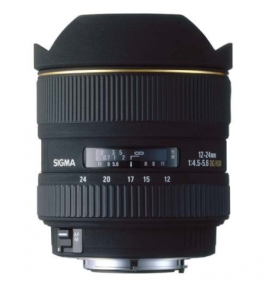Let’s start off by taking a look at how these two lenses compare when mounted on a Canon 5D Mark II body:
Sigma 12-24mm F4.5-5.6 EX DG HSM II Canon vs Sigma 12-24mm F4.5-5.6 EX DG Canon
The most striking improvement for the EX DG HSM II is with respect to chromatic aberration, thanks to the use of FLD (“F” low dispersion) glass, specially formulated to simulate the transmission properties of fluorite glass (i.e., lower refractive index and dispersion as compared to other optical glass). There is marked suppression of chromatic aberration at 12mm, particularly in the image center, and at 24mm, chromatic aberrations completely disappear.
Vignetting, transmission, and resolution for the HSM II also show improvement over the earlier EX DG lens, but nowhere near as dramatic:
- For vignetting, there is a net improvement at the 12mm focal length (e.g., f/4.5-5.6), and an overall improvement at all focal lengths from f/8 onwards.
- Transmission results remain low for both lenses, with a scarcely-worth-mentioning improvement of only 0.2 stop for the HSM II.
- For resolution, the HSM II generally better in the center and worse on the edges (for example, at 17mm, f/5).
One surprise, however, is that the HSM II scores worse for distortion than its predecessor. For both lenses, distortion is visible at 12mm, but negligible at higher focal lengths.
Although the EX DG HSM II’s DxOMark overall score (11) beats the EX DG’s score (10), obviously the improvements are not so significant as to induce EX DG owners to run out and replace their old lens with the newer model. For photographers looking for a wide-angle zoom and trying to decide between the HSM II and the EX DG, it is not clear that the improvements to the newer model are worth the more than 50% markup in price over the previous version.





DXOMARK encourages its readers to share comments on the articles. To read or post comments, Disqus cookies are required. Change your Cookies Preferences and read more about our Comment Policy.